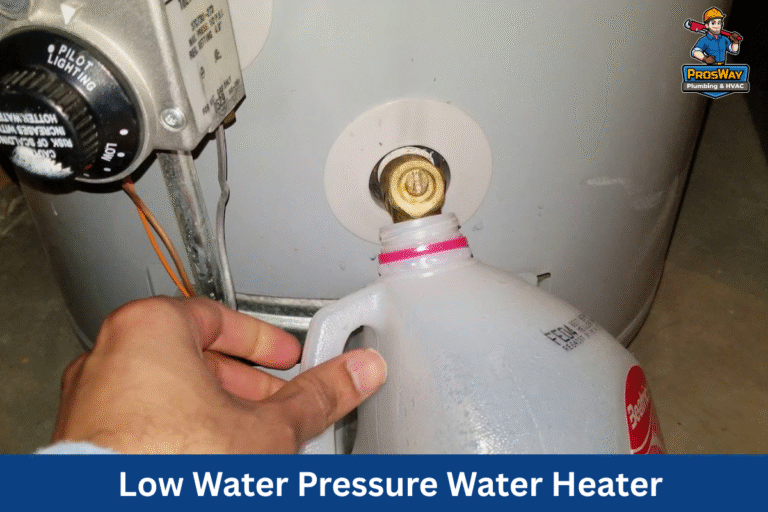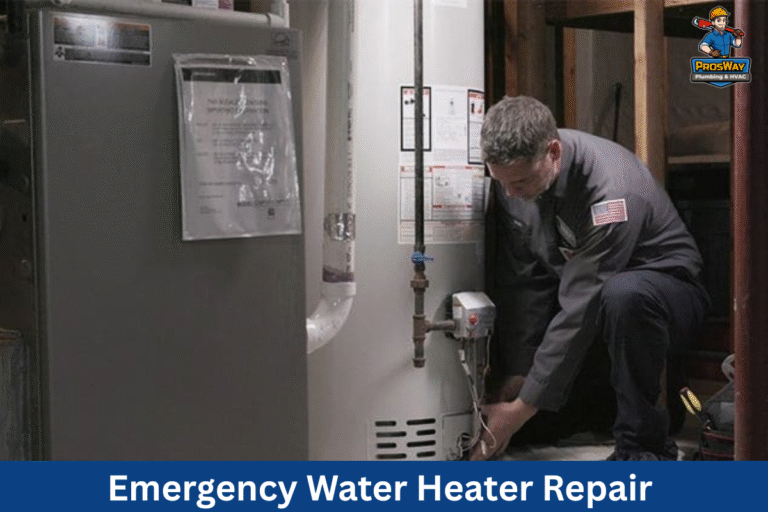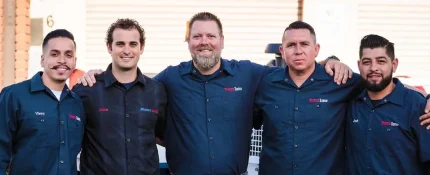At ProsWay Plumbing & HVAC, we know that choosing the right solution for damaged sewer lines can feel overwhelming.
Two of the most effective trenchless options we offer are epoxy pipe lining and pipe bursting—each with its unique advantages.
This article will walk you through the benefits and drawbacks of epoxy and pipe bursting for repairs, helping you determine which method best suits your home’s plumbing needs.
What Are Epoxy Pipe Lining and Pipe Bursting Methods?
Epoxy pipe lining provides an effective method for sewer repair by applying a resin coating to existing pipes, forming a new layer.
On the other hand, pipe bursting involves replacing old pipes by breaking them apart while installing new ones.
These core differences help in identifying the right approach for specific situations, ensuring efficient pipe repair solutions.
How Epoxy Pipe Lining Works for Sewer Repair?
Epoxy pipe lining is a trenchless method that offers a practical solution for sewer repair, particularly for drains made of clay.
This technique involves inserting a resin-coated liner into the existing pipe, which, once positioned, is inflated to adhere to the pipe’s interior.
As the resin cures, it forms a new, durable lining that effectively seals leaks and restores the pipe’s functionality.
Check out this video, the Epoxy Pipe lining process explained.
One major advantage of using epoxy pipe lining is the minimal disruption it causes to the landscape.
Homeowners can avoid the lengthy process of digging trenches, which often leads to damage in adjacent areas.
This method reduces repair costs by eliminating the need for extensive restoration.
The Process Behind Pipe Bursting Replacement
Pipe bursting is an innovative trenchless sewer repair method that focuses on replacing old or damaged pipes.
The process starts by inserting a bursting head into the existing line, which then breaks apart the old pipe.
This technique is effective for addressing leaks without the need for extensive excavation. Making it a preferred choice for homeowners concerned about landscaping damage and repair pricing.
This replacement method minimizes property disruption, allowing technicians to execute sewer pipe repair with greater efficiency.
By eliminating the need for digging long trenches, homeowners can enjoy reduced costs and a quicker restoration process.
Differences Between Lining and Bursting Techniques
The primary distinction between epoxy pipe lining and pipe bursting lies in their approach to replacing or repairing damaged pipes.
Epoxy lining involves coating the interior of existing pipes and restoring functionality without removing the old infrastructure.
This method minimizes disruption and can reduce water pollution caused by leaks.
Making it a less invasive solution compared to the more involved process of repiping through pipe bursting.
In contrast, pipe bursting replaces an old pipe by breaking it apart while simultaneously installing a new one.
This technique utilizes advanced machinery to facilitate the replacement, which can be particularly beneficial in construction.
Although pipe bursting may involve more initial disruption, it ultimately addresses issues that could lead to future problems.
What Are the Advantages of Epoxy Pipe Lining Repairs?
Epoxy pipe lining offers several advantages that make it a preferred method for sewer repair.
It minimizes property disruption, allowing homeowners to maintain their lawn while repairs are made.
This trenchless pipe solution is also quick, speeding up the restoration process, which saves time.
The cost-effectiveness of epoxy lining, especially compared to traditional digging methods, makes it an attractive option.
Each of these benefits plays a crucial role in enhancing plumbing systems in homes, including critical areas.
Minimal Property Disruption With Epoxy Solutions
Epoxy pipe lining significantly reduces property disruption during repairs, making it an ideal choice for homeowners.
This method involves minimal excavation, allowing technicians to complete repairs without disturbing essential areas.
As a result, homeowners can maintain their property’s aesthetics while ensuring that their drinking water systems remain free of leaks.
The use of resin in epoxy pipe lining creates a durable and effective barrier against leaks. Minimizing the potential for soil erosion and water damage in surrounding areas.
This approach extends the longevity of plumbing systems, providing a reliable solution for homeowners. By prioritizing minimal disruption, epoxy pipe lining enhances the overall repair experience.
How Fast Can Epoxy Pipe Lining Be Completed?
Epoxy pipe lining is known for its speed in completing pipeline restoration projects.
This trenchless technology significantly reduces the overall time required for repairs compared to traditional methods.
Since there is little to no excavation involved, the installation process can often be completed within a single day.
Minimizing disruptions to the household and maintaining water quality.
The efficiency of epoxy pipe lining helps prevent potential issues associated with prolonged downtime, such as damage to the roof or other key infrastructure.
With a quick turnaround, homeowners can restore their plumbing systems and enjoy reliable services shortly after repairs.
This rapid approach helps alleviate stress for residents who may be facing urgent plumbing concerns.
Why Is Epoxy Lining More Cost-Effective Than Digging?
Traditional sewer repair often comes with extra costs, such as landscaping restoration or sidewalk replacement.
With epoxy pipe lining, these expenses are largely avoided.
Homeowners can save thousands by choosing a method that doesn’t involve tearing up their property.
The benefits and drawbacks of epoxy and pipe bursting for repairs become especially clear when comparing long-term savings.
Epoxy pipe lining helps prevent future leaks, reducing the need for recurring repairs.
For expert advice or to explore trenchless solutions for your home, contact ProsWay Plumbing & HVAC today.
We specialize in modern sewer repair techniques that protect your home and your budget.
What Are the Potential Downsides of Using Epoxy Lining?

Epoxy lining offers many advantages for sewer line repair, but it also has certain limitations. Concerns may arise regarding the existing pipe condition, affecting the effectiveness of the application.
Long-term durability of epoxy seals can be uncertain, and there may be a potential reduction in pipe diameter.
Additionally, challenges may occur during application on specific pipe materials, alongside the cure time requirements.
Limitations Based on Existing Pipe Condition
The condition of the existing pipe significantly impacts the effectiveness of epoxy lining. For instance, pipes made from carbon or copper may present challenges if they exhibit severe corrosion.
In cases where the pipe is not structurally sound, the application of epoxy may not adhere properly.
Potentially leading to leaks or failures down the line, which can disrupt the homeowner’s driveway and outdoor areas.
The presence of significant cracks or breaks in the pipe may hinder the installation of an epoxy lining.
If water leaks are too extensive, the efficiency of the epoxy solution may be compromised, not fully addressing the issue.
What Should You Know About Epoxy Seal Durability?
Though epoxy linings are designed to be long-lasting, concerns around their durability often arise in homes with older pipes.
If the pipe surface isn’t adequately prepped, the epoxy may not adhere evenly, potentially leading to seal breakdowns over time.
These factors are part of the broader benefits and drawbacks of epoxy and pipe bursting for repairs that homeowners must evaluate.
Pipe age, environmental conditions, and water flow patterns can influence how well an epoxy lining performs over the years.
How Can Lining Affect Pipe Diameter and Drainage?
One potential downside of epoxy lining is the risk of reducing the pipe diameter after application. As the resin coating cures, it may lead to a slight decrease in the internal diameter of the pipe.
This change can impact the flow of water supply, which may result in slower drainage and increased pressure.
Homeowners should consider this reduction when deciding on epoxy lining.
If the existing pipes are already narrow or compromised, the additional layer may further cause issues in the water supply.
Therefore, assessing the pipe’s current condition and consulting with a plumbing expert.
It can ensure that the choice between epoxy lining and pipe bursting is well-informed for long-term plumbing effectiveness.
What Are the Strengths Associated With Pipe Bursting Replacement?

Pipe bursting offers a range of strengths that make it a compelling choice for sewer repairs. This method allows for the installation of entirely new pipes, providing a fresh start.
It also enables the upsizing of existing pipe diameters, making it ideal for severely damaged or collapsed pipes.
New piping materials promise a long service life with fewer joints than sectional repairs.
Achieving a Completely New Pipe Installation
Pipe bursting is a reliable method for achieving a completely new pipe installation. Ensuring homeowners can replace old, damaged pipes with new ones efficiently.
This technique involves breaking apart the existing pipe while simultaneously installing a new pipe. Providing a seamless transition that enhances the plumbing system’s overall reliability.
For those dealing with frequent plumbing issues, pipe bursting can offer a fresh start, eliminating the risks.
Opting for a new pipe installation through pipe bursting allows homeowners to upsize their existing pipe diameters.
It improves water flow and drainage capabilities This is particularly beneficial for properties experiencing recurring clogs or slow drainage.
Upgraded pipes can reduce pressure and enhance the overall performance of the plumbing system.
Why Is Upsizing Pipe Diameter a Valuable Feature?
Another important feature of pipe bursting is the ability to upsize the pipe diameter during installation.
If your current sewer line has inadequate flow capacity, pipe bursting allows for a larger pipe to be installed.
This upgrade is especially beneficial for homes undergoing renovations or additions that increase water demand.
Upsizing during pipe bursting helps prevent recurring issues like backups and slow drains, enhancing system performance.
These strengths are among the most practical benefits and drawbacks of epoxy and pipe bursting for repairs.
That homeowners should consider when choosing the right trenchless solution.
When Is Pipe Bursting Ideal for Severe Pipe Damage?
Pipe bursting is highly suitable for severely damaged or collapsed pipes. Making it an effective option for homeowners facing significant plumbing challenges.
This method replaces old pipes by breaking them apart and installing new ones. Ensuring that the system can handle daily water flow and waste management without risks.
For example, homes experiencing frequent backups or drainage issues due to collapsed pipes.
It will benefit from this reliable solution that restores functionality swiftly.
In cases where pipes are extensively damaged, epoxy lining may not provide the necessary repair.
Pipe bursting, on the other hand, addresses the critical need for complete replacement, eliminating concerns about leaks.
By opting for this method, homeowners can ensure a long-lasting plumbing system.
What Are the Limitations and Concerns for Pipe Bursting?
Pipe bursting, while effective, has several limitations that homeowners should consider.
The installation requires entry and exit pits, which can disrupt the surrounding area.
It may also pose risks to nearby utilities or structures and involve higher upfront costs compared to epoxy lining.
Success depends on soil conditions, and this method is less suitable for pipes with multiple sharp bends.
Why Are Entry and Exit Pits Required for Pipe Bursting?
The installation of pipe bursting requires the creation of entry and exit pits.
These pits allow technicians to access the existing plumbing while also facilitating the installation of new pipes.
However, this need for additional digging can disrupt landscaping and adjacent structures. This may concern homeowners who prioritize maintaining the appearance of their property during repairs.
Homeowners should understand that while entry and exit pits are necessary for the pipe bursting process.
The long-term benefits of replacing deteriorating pipes often outweigh the temporary disruption. Proper planning and communication with plumbing professionals can help minimize inconveniences.
By understanding the implications of entry and exit pits, property owners can make more informed decisions.
How Can Nearby Utilities or Structures Be Affected?
During the pipe bursting process, the need for entry and exit pits can pose risks to nearby utilities or structures.
These pits allow technicians to manage the replacement of old pipes, but they may disrupt underground systems.
Homeowners should be aware of the potential for accidental damage to these utilities, which can lead to service interruptions.
To mitigate risks, plumbing professionals need to conduct thorough site assessments.
This planning stage includes locating and marking existing utility lines, ensuring technicians can navigate around them safely.
Limited Applicability for Pipes With Multiple Sharp Bends
Pipe bursting may not be the ideal solution for plumbing systems that contain multiple sharp bends.
This method relies on a continuous path for the new pipe to travel, and sharp bends can complicate the installation process.
Homeowners with systems featuring numerous twists and turns should consult with experts to assess alternative repair methods.
Such as epoxy lining, might offer more effective solutions without the risks posed by complicated geometries.
In situations where existing pipes have sharp bends, the pipe bursting technique can lead to complications.
For instance, the equipment used in pipe bursting may struggle to navigate around these tight angles, potentially causing delays.
Homeowners facing these issues should consider discussing their options with plumbing professionals.
How to Make the Right Choice Between Epoxy and Pipe Bursting?

Choosing between epoxy and pipe bursting methods for repairs involves several key factors.
Homeowners should assess the severity of pipe damage and evaluate property layout and access constraints.
Furthermore, considering the longevity needs of the piping system and matching the repair method to specific pipe material types.
How Does Pipe Damage Severity Influence Repair Methods?
Assessing the severity of pipe damage is crucial in determining the appropriate repair method.
For instance, if the existing pipes show only minor leaks or small cracks, epoxy pipe lining may provide an effective solution.
In contrast, if the pipes are severely damaged or have collapsed, homeowners should consider pipe bursting.
As the better option to ensure a complete replacement and prevent further plumbing problems.
What Property Layout and Access Constraints Should Be Considered?
Evaluating property layout and access constraints is essential when choosing between epoxy pipe lining and pipe bursting for repairs.
Homeowners must consider factors such as the landscape’s configuration, the location of existing structures, and the presence of utility lines may restrict access.
For instance, if a property has extensive landscaping or uneven terrain, epoxy lining might be more suitable.
This method requires less disruption compared to the more invasive pipe bursting process. Additionally, access points play a critical role in determining the most effective repair method.
If a home has limited entry points for machinery, pipe bursting may pose challenges due to the need for excavation pits.
In such cases, a thorough assessment of all accessibility options allows homeowners to select a method that minimizes disruption.
How Do Pipe Material Types Affect the Choice of Repair Method?
When selecting a repair method, it is essential to consider the specific pipe material types. For instance, epoxy lining is often effective for older pipes made from materials like clay or PVC.
It can create a strong bond and seal leaks without requiring extensive excavation. However, materials such as cast iron may present challenges, especially if they show significant corrosion.
Conversely, pipe bursting may be the best choice for severely damaged or collapsed pipes made from various materials.
This technique efficiently replaces the old infrastructure. Ensuring reliable performance while accommodating common materials like PVC and HDPE.
Homeowners facing issues with pipes that are prone to significant deterioration should consult with plumbing professionals.
Conclusion
The benefits and drawbacks of epoxy and pipe bursting methods are crucial for homeowners facing plumbing repairs. Each approach offers unique advantages, such as the minimal disruption of epoxy lining and the complete replacement of pipe bursting. By assessing factors like pipe condition and property layout, homeowners can make informed decisions that enhance the longevity. Ultimately, choosing the right repair method ensures efficient solutions that protect against future plumbing issues.
Ready to Address Your Plumbing Concerns? Call ProsWay!
Don’t let plumbing issues disrupt your daily life. Contact ProsWay Plumbing & HVAC today to schedule a consultation. Our team is dedicated to providing efficient, reliable, and cost-effective solutions tailored to your home’s needs. Call us now at (862) 260-5870 or Book Online for residential clients in Parsippany and neighboring areas of North Jersey.









